Green Development of Natural Fibre-Based Paper Mulch from Recyclable Cow Dung and Flax Straw Waste
Abstract
1. Introduction
2. Materials and Methods
2.1. Materials
2.2. Test Methods
2.2.1. Composition Determination
2.2.2. Preparation of Paper Mulch Samples
2.2.3. Measurement and Characterization of the Pulps
- (1)
- Fourier transform infrared (FTIR) spectroscopy analyses:
- (2)
- X-ray diffraction (XRD) analyses:
- (3)
- Scanning electron microscopy (SEM) analyses of the pulps:
2.2.4. Measurement and Characterization of the Fibre Paper Mulch
- (1)
- Thermogravimetric analyses (TGA)
- (2)
- SEM analyses of the paper mulch samples:
- (3)
- Mechanical properties testing:
2.2.5. Measurement and Characterization of the Physical Properties of AKD-Coated Paper Mulch
- (1)
- Contact angle testing:
- (2)
- Three-dimensional roughness analyses:
- (3)
- X-ray photoelectron spectroscopy (XPS) analyses:
- (4)
- Mechanical properties testing:
- (5)
- TGA analyses:
3. Results and Analyses
3.1. Component Analyses
3.2. Analyses of the Pulps
3.2.1. FTIR Analyses of the Mixed Pulp
3.2.2. XRD Analyses of Mixed Pulp
3.2.3. The SEM Analyses of the Three Kinds of Pulps
3.3. The Characterization and Performance of the Paper Mulch
3.3.1. The TGA Analyses of the MPM
3.3.2. SEM Analyses of the Fibre Paper Mulch
3.3.3. Mechanical Properties of the Three Kinds of Base Fibre Paper Mulch Samples
- (1)
- Tensile strength analyses of three kinds of samples:
- (2)
- Tear strength analyses of three kinds of samples:
3.4. The Performance and Characterization of the Fibre Paper Mulch before and after Coating with AKD
3.4.1. Contact Angle of the Fibre Paper Mulch before and after Coating with AKD
3.4.2. The Roughness Analyses of the Fibre Paper Mulch before and after Coating with AKD
3.4.3. The XPS Analyses of the Fibre Paper Mulch before and after Coating with AKD
3.4.4. Mechanical Properties of the AKD-Coated Paper Mulch
4. Conclusions
Author Contributions
Funding
Institutional Review Board Statement
Informed Consent Statement
Data Availability Statement
Conflicts of Interest
References
- Qin, Y.Q.; Chai, Y.W.; Li, R.; Li, Y.W.; Ma, J.T.; Cheng, H.B.; Chang, L.; Chai, S.X. Evaluation of straw and plastic film mulching on wheat production: A meta-analysis in Loess Plateau of China. Field Crop. Res. 2022, 275, 108333. [Google Scholar] [CrossRef]
- Li, A.L.; Li, K.S.; Zhang, F.Y.; Ren, S.Y.; Zhang, F.W.; He, Q. Research on low temperature performance of ZnO/SiO2 composite superhydrophobic paper mulch. J. Mater. Res. Technol. 2021, 14, 851–863. [Google Scholar] [CrossRef]
- Zhang, B.C.; Han, H.U.; Guo, Z.Y.; Gong, S.; Shen, S.; Liao, S.H.; Wang, X.; Zhou, S.L.; Zhang, Z.D. Plastic-film-side seeding, as an alternative to traditional film mulching, improves yield stability and income in maize production in semi-arid regions. J. Integr. Agric. 2023, 22, 1021–1034. [Google Scholar] [CrossRef]
- Yang, J.; Mao, X.M.; Wang, K.; Yang, W.C. The coupled impact of plastic film mulching and deficit irrigation on soil water/heat transfer and water use efficiency of spring wheat in Northwest China. Agric. Water Manag. 2018, 201, 232–245. [Google Scholar] [CrossRef]
- Chelsea, M.R.; Timothy, H. The global odyssey of plastic pollution. Science 2020, 368, 1184–1185. [Google Scholar]
- Li, A.L.; Wang, J.W.; Ren, S.Y.; Zhang, J.Q.; Zhang, X.X.; Zhang, Y. Preparation of superhydrophobic paper mulch and study on its Anti-UV Performance. J. Saudi Chem. Soc. 2021, 25, 101322. [Google Scholar] [CrossRef]
- Yao, Z.; Seong, H.J.; Jang, Y.S. Environmental toxicity and decomposition of polyethylene. Ecotox. Environ. Saf. 2022, 242, 242113933. [Google Scholar] [CrossRef]
- Ray, S.; Cooney, R.P. Thermal degradation of polymer and polymer composites. In Handbook of Environmental Degradation of Materials; Elsevier: Amsterdam, The Netherlands, 2018; pp. 185–206. [Google Scholar]
- Fahmy, Y.; Fahmy, T.Y.A.; Mobarak, F.; El-Sakhawy, M.; Fadl, M.H. Agricultural residues (wastes) for manufacture of paper, board, and miscellaneous products: Background overview and future prospects. Int. J. ChemTech Res. 2017, 10, 424–448. [Google Scholar]
- El-Sayed, E.A.; El-Sakhawy, M.; El-Sakhawy, A.M. Non-wood fibers as raw material for pulp and paper industry. Nord. Pulp Pap. Res. J. 2020, 35, 215–230. [Google Scholar] [CrossRef]
- Tong, J.W.; Wang, X.; Kuai, B.B.; Gao, J.S.; Zhang, Y.L.; Huang, Z.H.; Cai, L. Development of transparent composites using wheat straw fibers for light-transmitting building applications. Ind. Crop Prod. 2021, 170, 113685. [Google Scholar] [CrossRef]
- Li, A.L.; Wang, G.F.; Zhang, Y.; Zhang, J.Q.; He, W.J.; Ren, S.Y.; Xu, Z.H.; Wang, J.W.; Ma, Y.W. Preparation methods and research progress of superhydrophobic paper. Coord. Chem. Rev. 2021, 449, 1–27. [Google Scholar] [CrossRef]
- Kumar, S.; Gaind, S. Fermentative production of soluble phosphorus fertilizer using paddy straw: An alternate to biomass burning. Int. J. Environ. Sci. Technol. 2019, 16, 6077–6088. [Google Scholar] [CrossRef]
- Yang, X.J.; Li, L.; Zhao, W.Y.; Wang, M.Y.; Yang, W.X.; Tian, Y.H.; Zheng, R.Z.; Deng, S.H.; Mu, Y.S.; Zhu, X.D. Characteristics and Functional Application of Cellulose Fibers Extracted from Cow Dung Wastes. Materials 2023, 16, 648. [Google Scholar] [CrossRef] [PubMed]
- Seyed, H.Y.; Salah, B.; Farid, A.; Hêmin, G. Modeling the optimal sizing problem of the biogas-based electrical generator in a livestock farm considering a gas storage tank and the anaerobic digester process under the uncertainty of cow dung. Energy 2023, 270, 126876. [Google Scholar]
- Baranu, S.B.; Ogugbue, J.C.; Okpokwasili, C.G. Effect of Pristine Soil Addition and Cow Dung Treatment on the Community Structure Post Bioremediation. Microbiol. Res. J. Int. 2021, 31, 36–44. [Google Scholar] [CrossRef]
- Romanko, C.A.; Gay, J.D.; Mark, P.J.; Michel, W.; Carol, B.; Larson, R.A.; Ruark, M.D. Soil greenhouse gas flux and nitrogen mineralization following manure application from tannin-fed dairy cows. J. Environ. Qual. 2023, 53, 12–22. [Google Scholar] [CrossRef]
- Tung, T.N.; Yuka, S.; Mitsuhiko, K.; Dhirendranath, S. Cow Manure Application Cuts Chemical Phosphorus Fertilizer Need in Silage Rice in Japan. Agronomy 2021, 11, 1483. [Google Scholar] [CrossRef]
- Kim, S.Y.; Jeong, S.T.; Ho, A.; Hong, C.O.; Lee, C.H.; Kim, P.J. Cattle Manure Composting: Shifts in the Methanogenic Community Structure, Chemical Composition, and Consequences on Methane Production Potential in a Rice Paddy. Appl. Soil Ecol. 2018, 124, 344–350. [Google Scholar] [CrossRef]
- Vijayaraghavan, P.; Lazarus, S.; Vincent, S.G.P. De-hairing protease production by an isolated Bacillus cereus strain AT under solid-state fermentation using cow dung: Biosynthesis and properties. Saudi J. Biol. Sci. 2014, 21, 27–34. [Google Scholar] [CrossRef]
- Abdeshahian, P.; Lim, J.S.; Ho, W.S.; Hashim, H.; Lee, C.T. Potential of Biogas Production from Farm Animal Waste in Malaysia. Renew. Sustain. Energy Rev. 2016, 60, 714–723. [Google Scholar] [CrossRef]
- Alemayehu, G. Co-Digestion of Municipal Organic Wastes with Night Soil and Cow Dung for Biogas Production: A Review. Afr. J. Biotechnol. 2016, 15, 32–44. [Google Scholar] [CrossRef]
- Mostafa, Y.; Mohammad, K.; Md, F.Y.; Chuah, A.L.; Reza, K.M.; Rashmi, W. Performance of Cow Dung Reinforced Biodegradable Poly(Lactic Acid) Biocomposites for Structural Applications. J. Polym. Environ. 2018, 26, 474–486. [Google Scholar]
- Puri, S.; Sharma, S.; Kumari, A.; Sharma, M.; Sharma, U.; Kumar, S. Extraction of lignocellulosic constituents from cow dung: Preparation and characterisation of nanocellulose. Biomass Conv. Bioref. 2020, 13, 311–320. [Google Scholar] [CrossRef]
- Xie, Y.P.; Yan, Z.L.; Niu, Z.X.; Coulter, J.A.; Niu, J.Y.; Zhang, J.P.; Wang, B.; Yan, B.; Zhao, W.; Wang, L.M. Yield, oil content, and fatty acid profile of flax (Linum usitatissimum L.) as affected by phosphorus rate and seeding rate. Ind. Crop. Prod. 2020, 145, 112087. [Google Scholar] [CrossRef]
- Dhyani, V.; Bhaskar, T.A. A comprehensive review on the pyrolysis of lignocellulosic biomass. Renew. Energy. 2018, 129, 695–716. [Google Scholar] [CrossRef]
- Bhanawat, P.D.; Patil, V.M. A Review on Advance Material with Jute Fiber-Polyester Reinforced Composites. Int. J. Text. Eng. Process. 2017, 10, 24–30. [Google Scholar]
- Ouagne, P.; Barthod-Malat, B.; Evon, P.; Labonne, L.; Placet, V. Fibre extraction from oleaginous flax for technical textile applications: Influence of pre-processing parameters on fibre extraction yield, size distribution and mechanical properties. Procedia Eng. 2017, 200, 213–220. [Google Scholar] [CrossRef]
- Liu, X.; Chen, C.J.; Sun, J.S.; Wang, X.H. Development of natural fiber-based degradable nonwoven mulch from recyclable mill waste. Waste Manag. 2021, 121, 432–440. [Google Scholar] [CrossRef] [PubMed]
- Van Soest, P.J.; Robertson, J.B.; Lewis, B.A. Methods for dietary fiber, neutral detergent fiber, and non-starch polysaccharides in relation to animal nutrition. J. Dairy Sci. 1991, 74, 3583–3597. [Google Scholar] [CrossRef] [PubMed]
- GB/T3332-2004; Determination of Beating Degree of Pulp (Scheuerre Regler Method). Standardization Administration of China: Beijing, China, 2004.
- Cao, X.Q.; Li, L.; Zhang, F.W.; Shi, L.X.; Zhang, F.Y.; Song, X.F.; Zhao, W.Y.; Dai, F. Optimization of the Green Fibre Paper Film Preparation Process Based on Box–Behnken Response Surface Methodology. Coatings 2023, 13, 2025. [Google Scholar] [CrossRef]
- EN ISO 5269-2-2005; Pulp Preparation of Laboratory Paperboard for Physical Experiments Part 2: Rapid-Kothen Method. DIN: Berlin, Germany, 2005.
- GB/T 35795—2017; Fully Biodegradable Agricultural Ground Covering Film. Standardization Administration of China: Beijing, China, 2017.
- GB/T 12914-2018; Paper and Paperboard—Determination of Tensile Strength—Constant Rate Tensile Method (20 mm/min). Standardization Administration of China: Beijing, China, 2018.
- GB/T 1040.1-2018; Determination of tensile properties of plastics Part 1: General principles. Standardization Administration of China: Beijing, China, 2018.
- QB/T 1130-1991; Test Method for Right Angle Tear Performance of Plastics. Standardization Administration of China: Beijing, China, 1991.
- Molin, U.; Teder, A. Importance of cellulose/hemicellulose-ratio for pulp strength. Nord. Pulp Pap. Res. J. 2002, 17, 14–19. [Google Scholar] [CrossRef]
- Zhang, S.Y.; Fei, B.H.; Yu, Y.; Cheng, H.T.; Wang, C.G. Effect of the amount of lignin on tensile properties of single wood fibers. For. Sci. Pract. 2013, 15, 56–60+2. [Google Scholar] [CrossRef]
- Jeetah, P.; Jaffur, N. Coconut Husk, a Lignocellulosic Biomass, as a Promising Engineering Material for Non-wood Paper Production. J. Nat. Fibers 2021, 19, 5622–5636. [Google Scholar] [CrossRef]
- Jahan, S.M.; Haris, F.; Rahman, M.M.; Sutradhar, P.R.S.S. Potassium hydroxide pulping of rice straw in biorefinery initiatives. Bioresource Technol. 2016, 219, 445–450. [Google Scholar] [CrossRef]
- Reddy, K.O.; Maheswari, C.U.; Dhlamini, M.S.; Mothudi, B.M.; Kommula, V.P.; Zhang, J.; Zhang, J.; Rajulu, A.V. Extraction and Characterization of Cellulose Single Fibers from Native African Napier Grass. Carbohydr. Polym. 2018, 188, 85–91. [Google Scholar] [CrossRef]
- Yang, H.p.; Yan, R.; Chen, H.P.; Lee, D.H.; Zheng, C.G. Characteristics of hemicellulose, cellulose and lignin pyrolysis. Fuel 2007, 86, 1781–1788. [Google Scholar] [CrossRef]
- Morán, I.J.; Alvarez, A.V.; Cyras, P.V.; Vazquez, A. Extraction of cellulose and preparation of nanocellulose from sisal fibers. Cellulose 2008, 15, 149–159. [Google Scholar] [CrossRef]
- Kouadri, I.; Satha, H. Extraction and Characterization of Cellulose and Cellulose Nanofibers from Citrullus Colocynthis Seeds. Ind. Crops Prod. 2018, 124, 787–796. [Google Scholar] [CrossRef]
- Vishnu Vardhini, K.J.; Murugan, R. Effect of Laccase and Xylanase Enzyme Treatment on Chemical and Mechanical Properties of Banana Fiber. J. Nat. Fibers 2017, 14, 217–227. [Google Scholar] [CrossRef]
- Chen, W.S.; Yu, H.P.; Liu, Y.X.; Chen, P.; Zhang, M.X.; Hai, Y.F. Individualization of cellulose nanofbers from wood using high-intensity ultrasonication combined with chemical pretreatments. Carbohydr. Polym. 2011, 83, 1804–1811. [Google Scholar] [CrossRef]
- Moreno, M.L.; Gorinstein, S.; Medina, J.O.; Palacios, J.; Muñoz, E.J. Valorization of Garlic Crops Residues as Precursors of Cellulosic Materials. Waste Biomass Valorization 2020, 11, 4767–4779. [Google Scholar] [CrossRef]
- French, D.A.; Cintrón, S.M. Cellulose polymorphy, crystallite size, and the Segal Crystallinity Index. Cellulose 2013, 20, 583–588. [Google Scholar] [CrossRef]
- Azubuike, P.C.; Okhamafe, O.A. Physicochemical, spectroscopic and thermal properties of microcrystalline cellulose derived from corn cobs. Int. J. Recycl. Org. Waste Agric. 2012, 1, 9. [Google Scholar] [CrossRef]
- Chen, Y.M.; Wan, J.Q.; Zhang, X.L.; Ma, Y.W.; Wang, Y. Effect of beating on recycled properties of unbleached eucalyptus cellulose fiber. Carbohyd. Polym. 2012, 87, 730–736. [Google Scholar] [CrossRef]
- Azhar, W.S.; Zhang, Y.N.; Li, Z.F.; Xu, F.J.; Qiu, Y.M. Feasibility of flaxseed fiber bundles as reinforcement in green composites. In Proceedings of the Shanghai Textile and Clothing Creative Innovation Graduate Academic Forum and the 7th International Forum on Textile and Clothing Innovation, Shanghai, China, 5 July 2013; pp. 91–93. [Google Scholar]
- Souza, M.D.F.L.K.; Pilar, D.M.F.H.; Da, M.S.L. The Influence of Potassium Hydroxide Concentration and Reaction Time on the Extraction Cellulosic Jute Fibers. J. Nat. Fibers 2022, 19, 6889–6901. [Google Scholar]
- Reddy, K.O.; Maheswari, C.U.; Reddy, D.J.P.; Rajulu, A.V. Thermal properties of Napier grass fibers. Mater. Lett. 2009, 63, 2390–2392. [Google Scholar] [CrossRef]
- Agarwal, U.P. Raman imaging to investigate ultrastructure and composition of plant cell walls: Distribution of lignin and cellulose in black spruce wood (Picea mariana). Planta 2006, 224, 1141–1153. [Google Scholar] [CrossRef] [PubMed]
- Rowlandson, J.L.; Woodman, T.J.; Tennison, S.R.; Edler, K.J.; Ting, V.P. Influence of aromatic structure on the thermal behaviour of lignin. Waste Biomass Valorization 2022, 11, 2863–2876. [Google Scholar] [CrossRef]
- Khili, F.; Borges, J.; Almeida, L.P.; Boukherroub, R.; Omrani, A.D. Extraction of Cellulose Nanocrystals with Structure I and II and Their Applications for Reduction of Graphene Oxide and Nanocomposite Elaboration. Waste Biomass Valorization 2019, 10, 1913–1927. [Google Scholar] [CrossRef]
- Wang, C.; Cao, H.; Jia, L.Y.; Liu, W.L.; Liu, P.T. Characterization of antibacterial aerogel based on ε-poly-L-lysine/nanocellulose by using citric acid as crosslinker. Carbohydr. Polym. 2022, 29, 119568. [Google Scholar] [CrossRef] [PubMed]
- Carlos, M.; Brigitte, C.; Françoise, B.; Bercu, N.B.; Michael, M.; Véronique, A. Influence of Surface Chemistry of Fiber and Lignocellulosic Materials on Adhesion Properties with Polybutylene Succinate at Nanoscale. Materials 2023, 16, 2440. [Google Scholar] [CrossRef]
- Kian, L.K.; Jawaid, M.; Ariffin, H.; Karim, Z.; Sultan, M.T. Morphological, physico-chemical, and thermal properties of cellulose nanowhiskers from roselle fibers. Cellulose 2019, 26, 6599–6613. [Google Scholar] [CrossRef]
- Li, A.L.; Kang, Q.R.; Ren, S.Y.; Zhang, Y.; Zhang, F.W.; He, Q. Preparation of Superhydrophobic Composite Paper Mulching Film. Arab. J. Chem. 2021, 14, 103247. [Google Scholar] [CrossRef]
- Ström, G.; Carlsson, G.; Kiaer, M. Alkylketene dimer distribution in handsheets as determined by ESCA. Wochenbl. Papierfabr. 1992, 120, 606–619. [Google Scholar]
- Rauni, S. On the Internal Sizing Mechanisms of Paper with AKD and ASA Related to Surface Chemistry, Wettability and Friction; Universitetsservice US AB: Stockholm, Sweden, 2007. [Google Scholar]
- Fasake, V.; Dashora, K. A sustainable potential source of ruminant animal waste material (dung fiber) for various industrial applications: A review-ScienceDirect. Bioresour. Technol. Rep. 2021, 15, 100693. [Google Scholar] [CrossRef]
- Hossein, M.; Zahra, K. Synthesis and Application of Poly(diallyldimethylammonium tribromide) as a Novel Polymeric Brominating Agent. Chin. J. Chem. 2010, 28, 2221–2225. [Google Scholar] [CrossRef]
- Van, S.N.; Bong-Kee, L. Polyvinyl alcohol/alkyl ketene dimer films with excellent water resistance and water vapor barrier properties. Mater. Lett. 2022, 307, 131045. [Google Scholar]
- Naile, A.; Sena, C.; Murat, E.; Donmez, C.A. Effect of alkyl ketene dimer on chemical and thermal properties of polylactic acid (PLA) hybrid composites. Sustain. Mater. Technol. 2022, 32, e00386. [Google Scholar]
- Helong, S.; Tao, L.; Florent, G. Enhancing mechanical performance of green fiber cement composites: Role of eco-friendly alkyl ketene dimer on surfaces of hemp fibers. J. Mater. Res. Technol. 2024, 28, 3121–3132. [Google Scholar]
- Huang, S.C.; Wang, X.Y.; Zhang, Y.; Meng, Y.; Hua, F.G.; Xia, X.X. Water and oil-grease barrier properties of PVA/CNF/MBP/AKD composite coating on paper. Sci. Rep. 2023, 13, 12292. [Google Scholar] [CrossRef]
- Koray-Gulsoy, S.; Simsir, S. The effect of handsheet grammage on strength properties of test liner papers the effect of hand sheet grammage on strength properties of test. J. Bartin Fac. For. 2017, 19, 117–122. [Google Scholar]
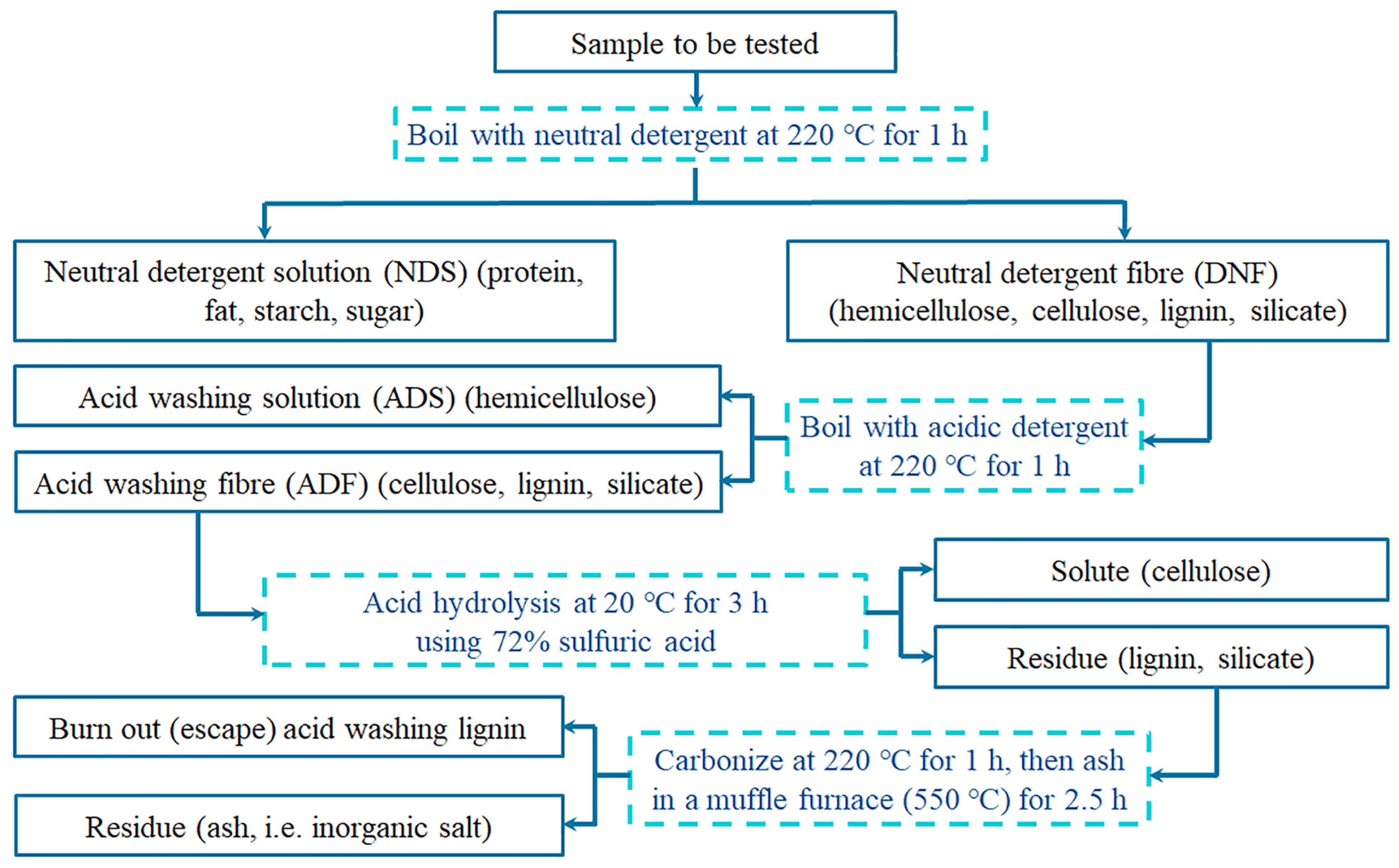
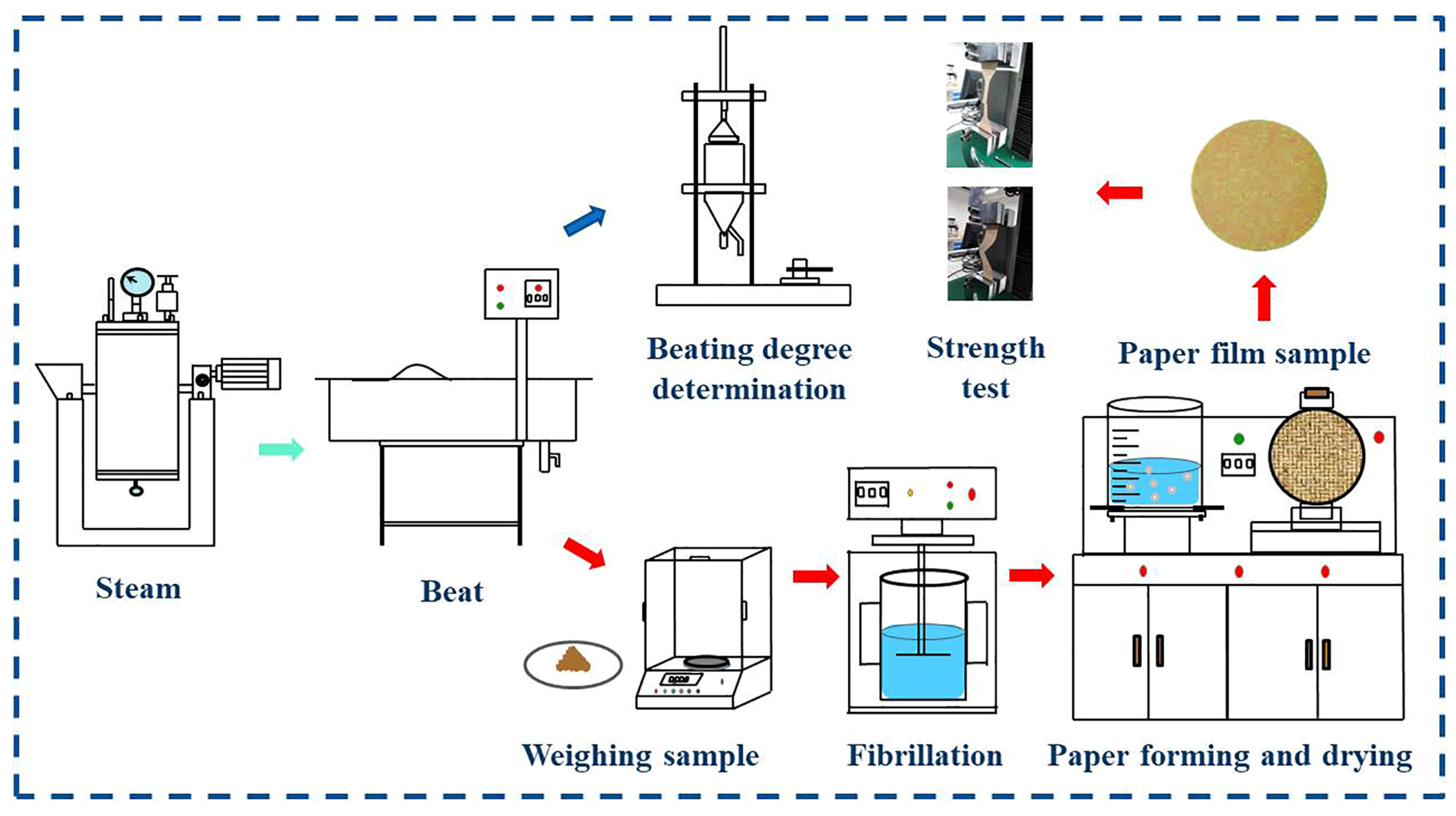
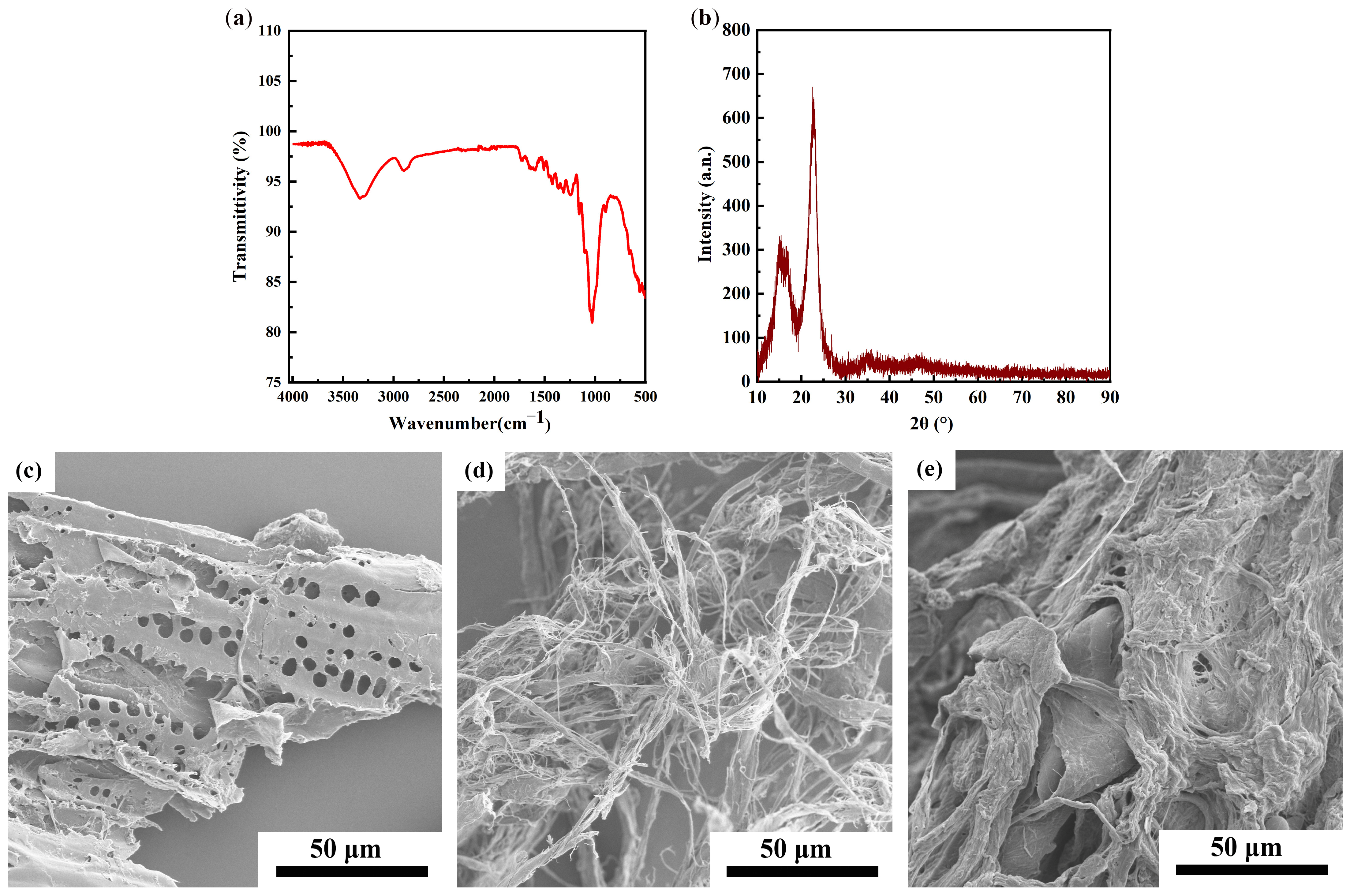
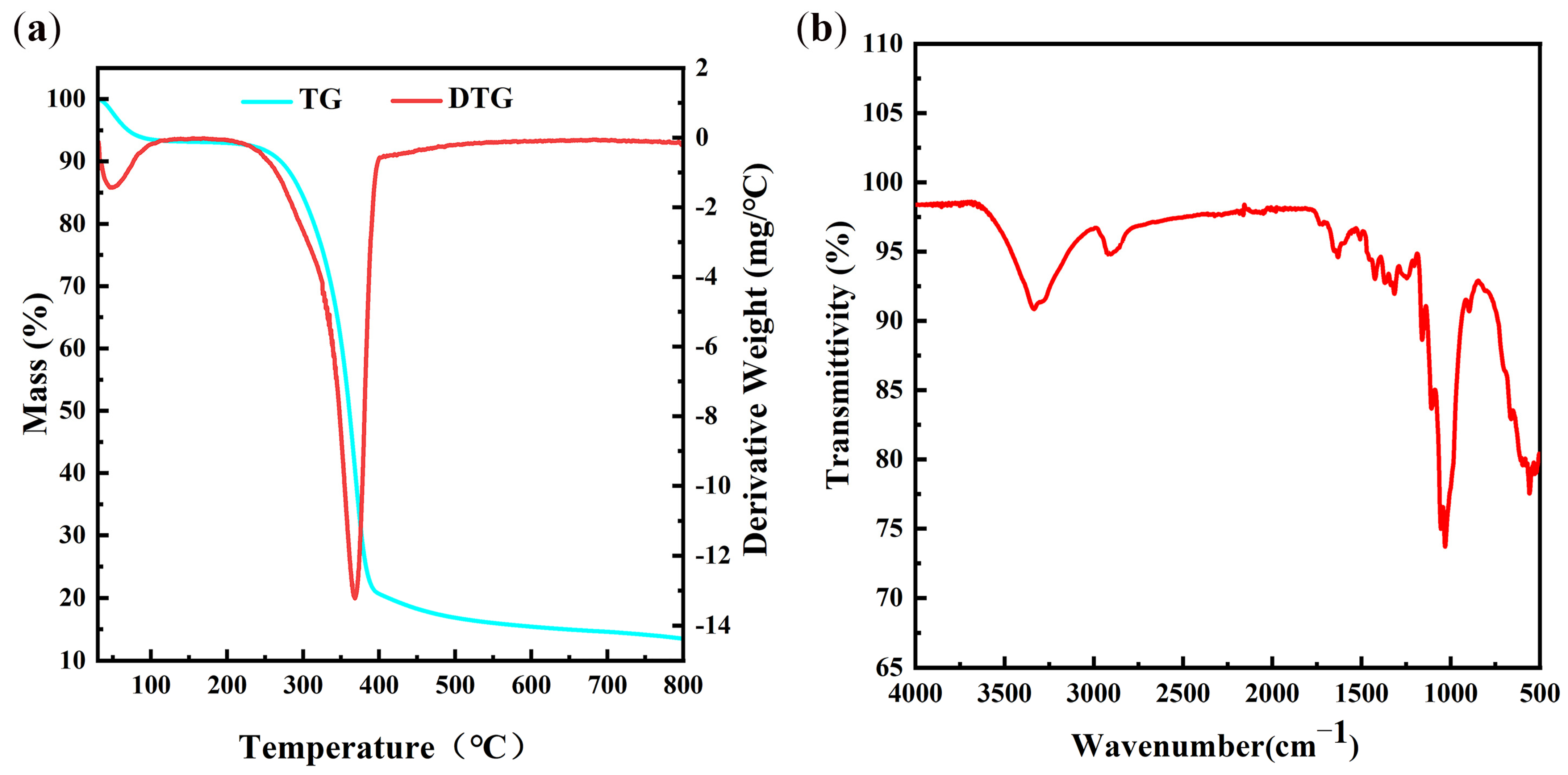
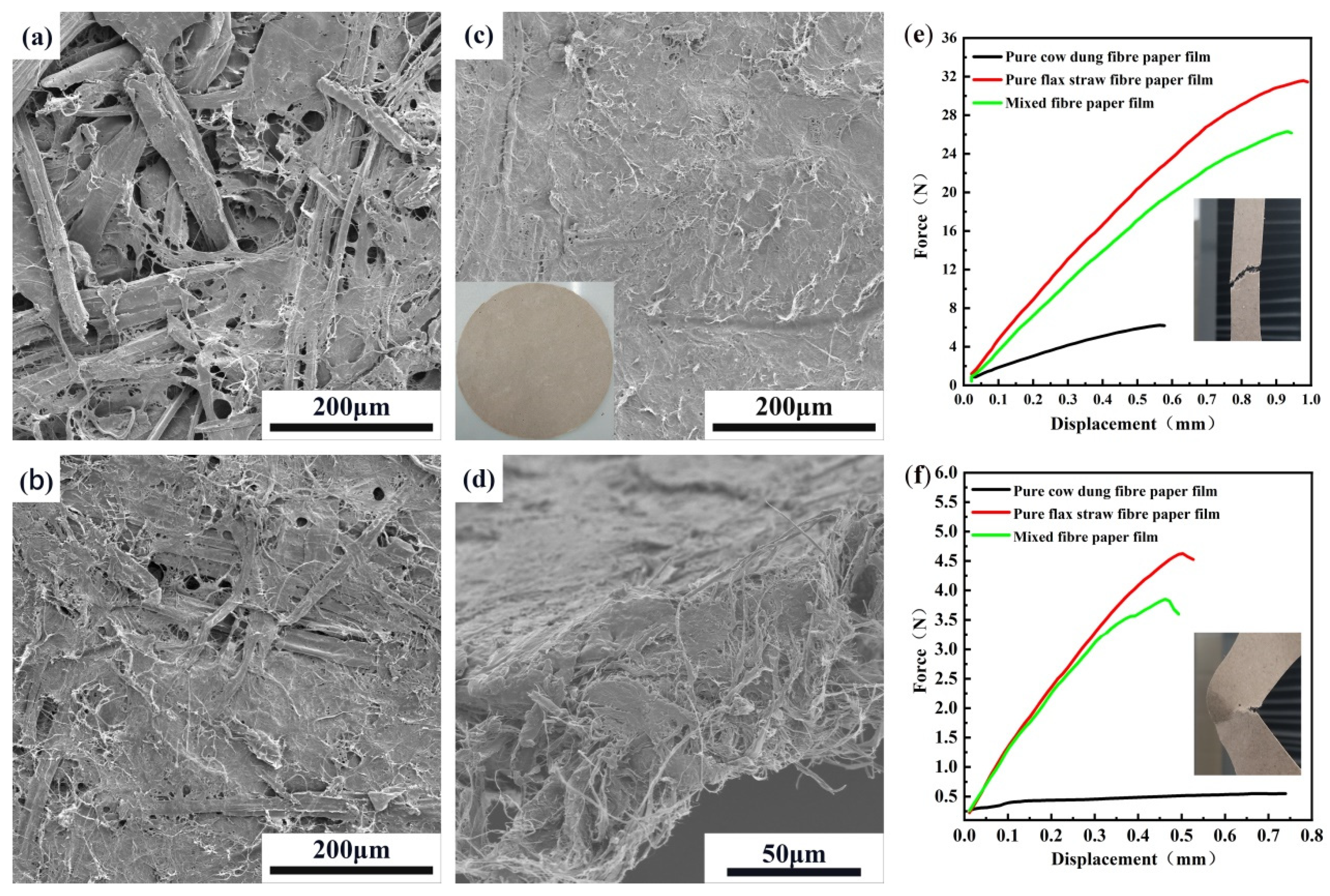
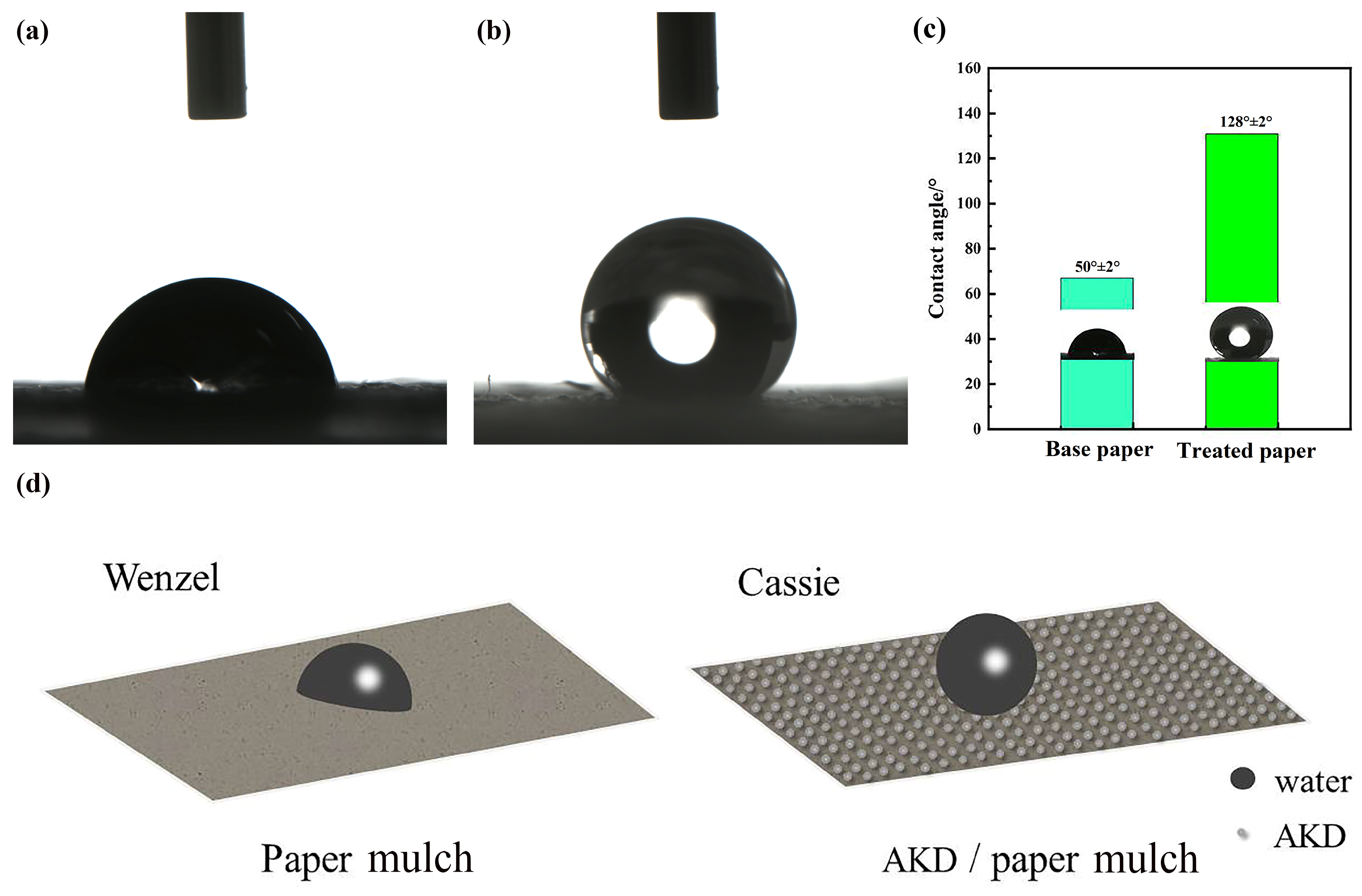
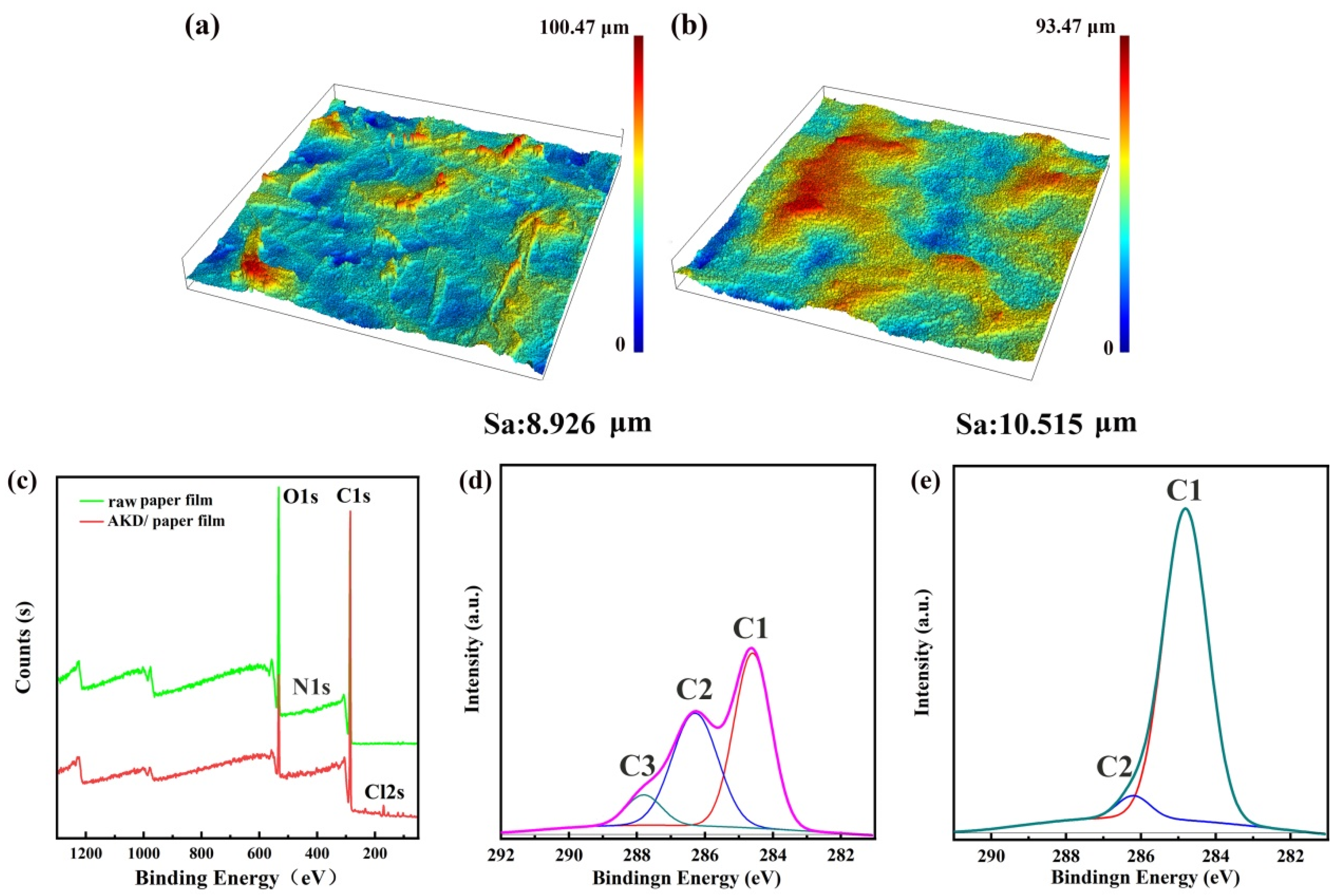
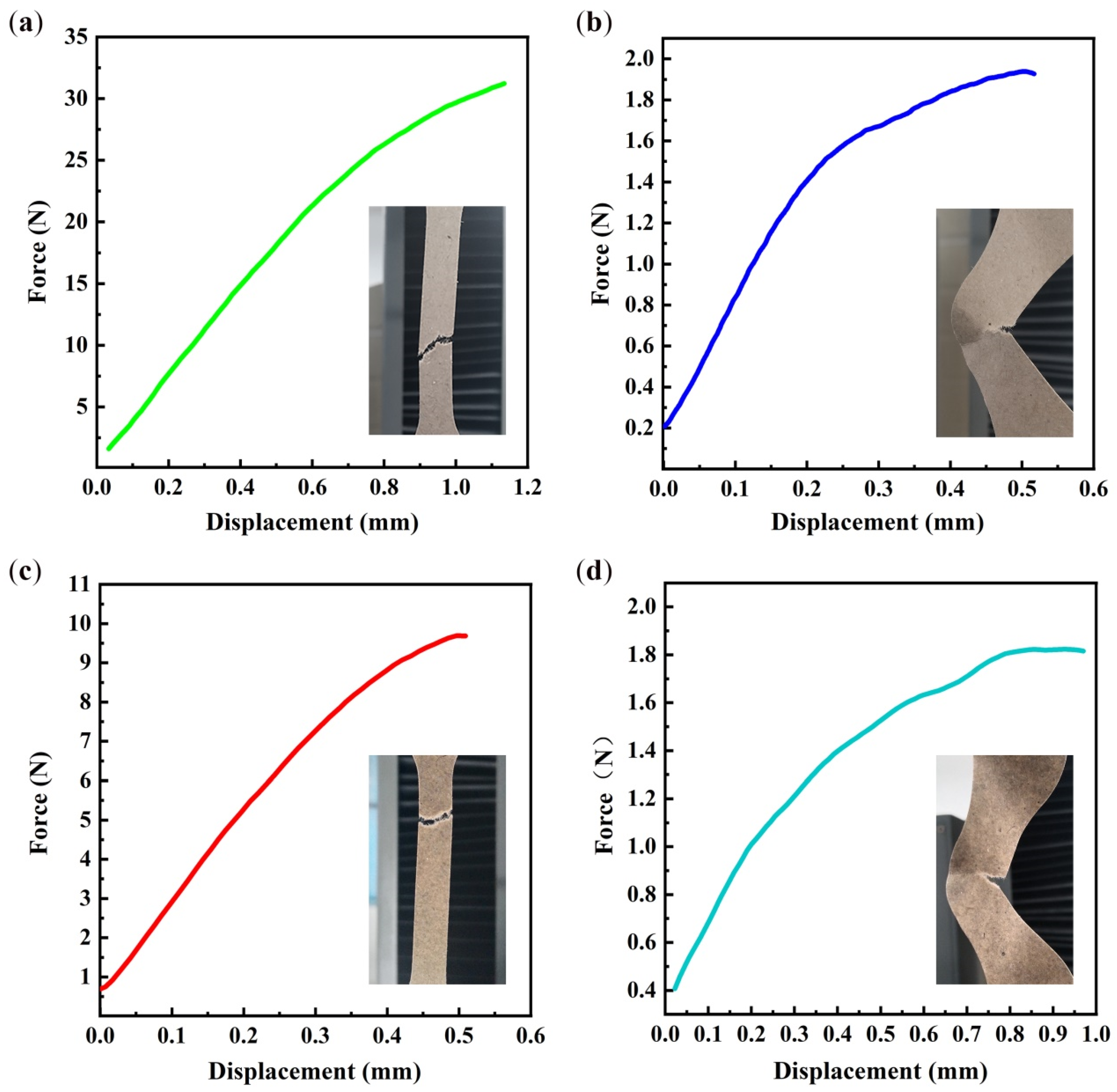
| Name of Material | Indicators of Components | ||||
|---|---|---|---|---|---|
| Hemicellulose (%) | Cellulose (%) | Acid Detergent Lignin (%) | Acid Insoluble Ash (%) | Bibliography | |
| Cow dung | 31.6 | 36.8 | 16.4 | 0.9 | - |
| Flax straw | 16.1 | 54.7 | 12.1 | 0.7 | - |
| Wheat straw | 26.0 | 51.0 | 16.0 | - | [41] |
| Sorghum straw | 24.43 | 41.50 | 15.04 | - | [42] |
| Oat straw | - | 31.0–48.0 | 16.0–19.0 | - | [41] |
| Alfalfa | 38.5 | 45.4 | 14.9 | - | [38] |
| Rice straw | 19.5 | 41.2 | 21.9 | - | [10] |
| Sample | The Base MPM | The AKD-Coated Fibre Paper Mulch | |
|---|---|---|---|
| Dry sample | The tensile strength (kN/m) | 1.85 | 2.13 |
| The tear strength (N/mm) | 19.34 | 16.43 | |
| Wet sample | The tensile strength (kN/m) | - | 0.64 |
| The tear strength (N/mm) | - | 8.23 | |
Disclaimer/Publisher’s Note: The statements, opinions and data contained in all publications are solely those of the individual author(s) and contributor(s) and not of MDPI and/or the editor(s). MDPI and/or the editor(s) disclaim responsibility for any injury to people or property resulting from any ideas, methods, instructions or products referred to in the content. |
© 2024 by the authors. Licensee MDPI, Basel, Switzerland. This article is an open access article distributed under the terms and conditions of the Creative Commons Attribution (CC BY) license (https://creativecommons.org/licenses/by/4.0/).
Share and Cite
Cao, X.; Li, L.; Zhang, F.; Zhang, F.; Song, X.; Zhao, W.; Dai, F. Green Development of Natural Fibre-Based Paper Mulch from Recyclable Cow Dung and Flax Straw Waste. Agronomy 2024, 14, 290. https://doi.org/10.3390/agronomy14020290
Cao X, Li L, Zhang F, Zhang F, Song X, Zhao W, Dai F. Green Development of Natural Fibre-Based Paper Mulch from Recyclable Cow Dung and Flax Straw Waste. Agronomy. 2024; 14(2):290. https://doi.org/10.3390/agronomy14020290
Chicago/Turabian StyleCao, Xiaoqing, Lu Li, Fengwei Zhang, Fangyuan Zhang, Xuefeng Song, Wuyun Zhao, and Fei Dai. 2024. "Green Development of Natural Fibre-Based Paper Mulch from Recyclable Cow Dung and Flax Straw Waste" Agronomy 14, no. 2: 290. https://doi.org/10.3390/agronomy14020290
APA StyleCao, X., Li, L., Zhang, F., Zhang, F., Song, X., Zhao, W., & Dai, F. (2024). Green Development of Natural Fibre-Based Paper Mulch from Recyclable Cow Dung and Flax Straw Waste. Agronomy, 14(2), 290. https://doi.org/10.3390/agronomy14020290







